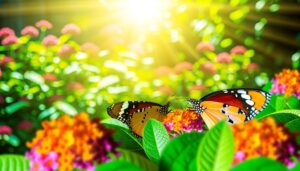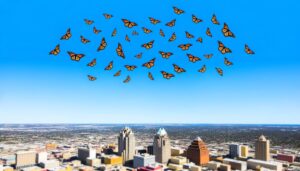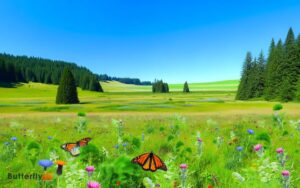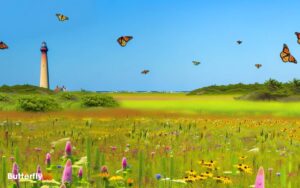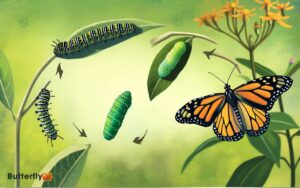Facts About the Monarch Butterfly: Discover Their Marvels!
Monarch butterflies travel up to 3,000 miles from North America to central Mexico each fall, orienting themselves with environmental cues like the sun and Earth’s magnetic field. Their life cycle has four stages: egg, larva, pupa, and adult.
Monarchs thrive in diverse habitats but rely on milkweed. They serve as pollinators, transferring pollen and promoting plant diversity.
Monitoring monarchs provides insights into ecosystem health. To explore their full story, there’s much more to discover.
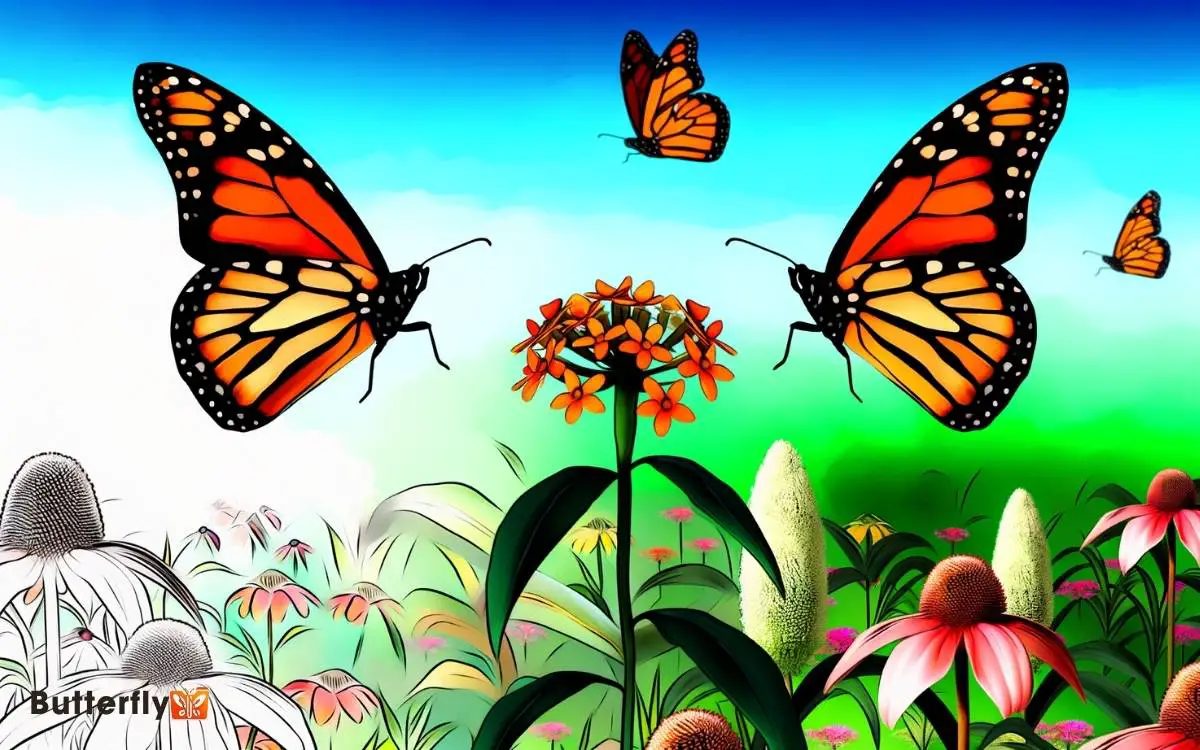
Key Takeaways
Migration Journey
Monarch butterflies begin an extraordinary migration journey, traveling up to 3,000 miles from North America to central Mexico each fall. You’ll find that this trek is one of nature’s most remarkable phenomena.
Using environmental cues like the position of the sun and earth’s magnetic field, monarchs navigate with surprising precision.
They fly at speeds between 12 and 25 miles per hour, covering about 50 to 100 miles a day. Along the way, they rest in trees and shrubs, often in large clusters.
This migration is unique because it spans multiple generations; no single butterfly completes the round trip. Understanding their migration can help you appreciate their resilience and the critical need for conservation efforts to protect their habitats.
Life Cycle Stages
You’ll find the life cycle of the monarch butterfly fascinating, as it consists of four distinct stages: egg, larva (caterpillar), pupa (chrysalis), and adult butterfly.
Initially, the female lays tiny, cream-colored eggs on milkweed leaves. In about four days, these eggs hatch into larvae, or caterpillars, which spend roughly two weeks voraciously eating milkweed to grow rapidly.
The caterpillar then forms a pupa, known as a chrysalis, where it undergoes significant transformation over about ten days.
Finally, the adult butterfly emerges, characterized by its vibrant orange and black wings.
Each stage is essential for the survival and development of the monarch, ensuring its readiness for the next phase of its incredible journey.
Metamorphosis Process
During the metamorphosis process, the monarch butterfly undergoes a remarkable transformation from a caterpillar into a chrysalis, where its tissues and organs are reorganized into the structures of an adult butterfly.
First, the caterpillar attaches itself to a leaf or stem using silk. It then sheds its outer skin to reveal the chrysalis. Inside, the caterpillar’s body breaks down through enzymatic processes.
Imaginal discs, specialized clusters of cells, differentiate into the wings, legs, and other adult features. This complex cellular reorganization is tightly regulated by hormones like ecdysone.
After approximately 10-14 days, the fully formed butterfly emerges from the chrysalis, ready to dry its wings and prepare for flight. This transformation is a marvel of developmental biology.
Habitat and Range
Spanning multiple continents, the monarch butterfly‘s habitat ranges from the temperate regions of North America to the tropical environments of Central and South America.
You’ll find these resilient insects in diverse ecosystems, including meadows, grasslands, and forests. They prefer areas with abundant milkweed, essential for laying eggs and nurturing larvae.
Monarchs are known for their astonishing migratory behavior, covering thousands of miles between breeding and wintering grounds.
In North America, they migrate to Mexico’s oyamel fir forests, where millions cluster together for warmth. Conversely, in coastal California, they roost in eucalyptus and Monterey pine trees.
Their expansive range demonstrates their adaptability to various climates and ecological conditions, making them a fascinating subject of study.
Diet and Feeding
Monarch butterflies primarily feed on nectar from various flowering plants, with a strong preference for milkweed, which also serves as an essential food source for their larvae.
You’ll notice that adult monarchs use their long proboscis to sip nectar, extracting important sugars and nutrients they need for energy.
Milkweed plants are particularly significant as they contain cardenolides, toxic compounds that monarchs can tolerate and store in their bodies, providing them with protection from certain predators.
When you observe monarch larvae, you’ll find they exclusively feed on milkweed leaves. This diet not only facilitates their growth but also incorporates the plant’s toxins into their system, making them distasteful to many would-be predators.
This specialized feeding strategy is integral to their survival.
Predators and Threats
You’ll find that monarch butterflies face numerous threats in their environment. Natural predators like birds and insects pose significant risks, while habitat loss due to human activities further endangers their survival.
Additionally, climate change affects their migratory patterns and breeding grounds, complicating their life cycle.
Natural Predators
Among the many threats to monarch butterflies, natural predators such as birds, spiders, and wasps pose significant risks to their survival.
You’ll find that these predators target different life stages of the monarch:
- Eggs: Tiny wasps often lay their eggs inside monarch eggs, leading to the destruction of the monarch larvae.
- Caterpillars: Spiders and predatory beetles frequently capture and consume monarch caterpillars.
- Adults: Birds, especially species like the black-headed grosbeak, have developed resistance to the monarch’s toxic cardenolides and can safely eat adult butterflies.
Understanding these natural threats will help you appreciate the complex ecosystem interactions that affect monarch populations. Keep in mind that these predators are part of a balanced ecosystem, even though they pose a danger to monarchs.
Habitat Loss
While natural predators play a significant role in the mortality of monarch butterflies, habitat loss presents an even more urgent threat to their survival.
You should know that deforestation in their overwintering sites in Mexico eliminates critical roosting areas. Additionally, agricultural expansion and urban development in North America reduce the availability of milkweed, the sole food source for monarch caterpillars.
Herbicide use further exacerbates this problem by killing milkweed plants. Without these essential habitats, monarchs can’t complete their life cycle, leading to population decline.
Conservation efforts, such as planting milkweed and protecting overwintering sites, are vital. By understanding these threats, you can contribute to the preservation of this iconic species.
Climate Change
Climate change poses a significant threat to monarch butterflies by altering their migratory patterns and disrupting their breeding and feeding grounds.
Rising temperatures can trigger premature migration, leading to:
- Mismatched Timing: Monarchs may arrive before milkweed, their primary food source, has emerged.
- Habitat Degradation: Increased frequency of extreme weather events can destroy critical roosting sites.
- Altered Ecosystems: Changes in precipitation patterns can reduce the availability of nectar plants.
Conservation Efforts
Efforts to conserve monarch butterflies focus on habitat preservation, reduction of pesticide use, and public education to guarantee their survival.
You should plant native milkweed and nectar plants to provide food and breeding grounds. Avoid using pesticides, especially neonicotinoids, as they’re highly toxic to monarchs and other pollinators. Support organic farming practices that reduce chemical runoff into critical habitats.
Educate your community about the monarch’s migratory patterns and their ecological needs. Participate in citizen science projects to monitor populations and gather data on their health and migration.
Ecological Importance
You should recognize that monarch butterflies play a crucial role in pollination, aiding in the reproduction of many flowering plants.
They also serve as an essential food source for various predators, contributing to the stability of food webs.
Additionally, their presence indicates the health of ecosystems, making them indispensable biodiversity indicators.
Pollination and Plant Reproduction
With their intricate migratory patterns and meticulous feeding habits, monarch butterflies play a pivotal role in the pollination process, greatly aiding in plant reproduction and maintaining ecological balance.
As they travel, monarchs transfer pollen from flower to flower, facilitating genetic diversity among plant species.
This process is critical for several reasons:
- Biodiversity: Monarchs help increase plant genetic diversity, leading to healthier ecosystems.
- Food production: Many crops rely on insect pollinators like monarchs for fruit and seed production.
- Ecosystem stability: By supporting plant reproduction, monarchs help maintain habitats that other species depend on.
You’ll find that monarchs are indispensable not only for their beauty but also for their essential ecological contributions.
Food Web Contributions
Monarch butterflies, through their roles as both pollinators and prey, greatly impact the structure and dynamics of food webs in their ecosystems.
As pollinators, they facilitate the reproduction of various flowering plants, ensuring the availability of food resources for other species. By visiting multiple flowers, monarchs transfer pollen, promoting genetic diversity and plant health.
When monarchs serve as prey, they’re an important food source for predators like birds, spiders, and insects. Their presence supports these predator populations, maintaining ecological balance.
Monarch larvae, feeding on milkweed, incorporate toxic compounds that deter many predators, thus influencing predator-prey interactions.
You’ll find that monarch butterflies play a pivotal role in sustaining the intricate web of life within their habitats.
Biodiversity Indicator Species
Serving as a biodiversity indicator species, monarch butterflies reflect the overall health of their ecosystems due to their sensitivity to environmental changes.
You can observe these changes through the monarchs’ presence, behavior, and population dynamics. Their decline often signals broader ecological issues, such as habitat loss, climate change, and pesticide use.
By monitoring monarch populations, you can gain insights into the following areas:
- Habitat Quality: Healthy monarch populations indicate well-maintained habitats with abundant milkweed and nectar sources.
- Climate Impact: Shifts in migration patterns and timing reveal climate change effects.
- Pesticide Impact: Reduced numbers can highlight harmful pesticide levels in the environment.
Understanding these indicators helps you assess and address the ecological health of your surroundings.
Conclusion
You’ve journeyed through the majestic migration, meticulous metamorphosis, and marvelous life cycle stages of the monarch butterfly.
From their diverse diet to their challenging predators, these delicate creatures demonstrate resilience and ecological importance.
Conservation efforts are essential to combat the looming threats they face. By understanding their habitat and range, you can contribute to ensuring these splendid species continue to soar.
So, let’s safeguard the stunning monarch and secure its survival for future generations.

